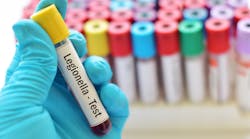Legionella isn't a topic that facility managers and owners should take lightly.
The Centers for Disease Control and Prevention reports there are an estimated 5,000 cases of Legionnaire's disease reported every year in the United States. And that number is on the rise.
It has not gone unnoticed by our industry, and the approval of ASHRAE Standard 188-2015 puts even greater emphasis on minimizing the risk and taking steps to protect building occupants.
There are a variety of sources for Legionella—showers and faucets, hot water tanks, large plumbing systems, fountains and water features—but one of the more common culprits behind outbreaks are cooling towers. Whenever Legionella growth does occur, it's often attributed to accumulated algae, mold or bacteria within a dirty cooling tower mixing with the tower's warm water; the combination is a perfect environment for bacterial growth.
Legionnaire's disease spreads when infected water is dispersed through the air as an aerosol. Cooling towers are typically on top of buildings, which means mist and droplets affected with the bacteria can travel miles.
The potential impact of poor air quality goes beyond the facility itself. The air quality created by the mist and vapor released from these systems can have significant effect on the health of pedestrian traffic and neighboring facilities.
The importance of ongoing maintenance and cleaning isn't a new concept or surprise, but understanding the need versus executing are two different things. Alarmingly, there are a variety of studies showing that 40 to 60% of cooling towers have tested positive for Legionella.
The 2015 outbreak in South Bronx that killed 12 people shined the spotlight on how critical it is to perform cooling tower maintenance. And that's what it boils down to—good industrial hygiene practices.
Dirty cooling tower systems are more likely to harbor deadly bacteria such as Legionella. Properly maintaining your cooling tower system with specialized systems for cleaning mud, and silt from cooling tower basins, dissolving and removing scale from cooling tower fill, and following a well-maintained water treatment program will go a long way in the prevention of Legionella and other potential bacteria.
What can you do to reduce the risk of Legionella?
- Inspect Towers Monthly. Sediment, scale and slime can lead to buildup and help legionella grow and thrive. Regular inspections will help determine when to schedule cleaning.
- Clean Tower Basin Surfaces. When sediment is visible, the basin needs to be cleaned, and specially designed cooling tower vacuums make it easier to remove contaminants without shutting down or draining your system.
- Treat Circulating Water. Use appropriate corrosion inhibitors and dose biocides at recommended levels. Using a biofilm dispersant in conjunction with biocides enhances biological control.
- Clean the Fill. The tower fill provides the perfect environment for bacterial growth, especially legionella. Scale deposits caused by evaporation can be especially hard to remove. Consider a specialized cooling tower fill cleaner that helps dissolve and remove scale and mineral deposits. Protocols for disinfection of Legionella are well defined by the Occupational Safety and Health Administration, the Centers for Disease Control and Prevention and the U.S. Environmental Protection Agency.
- Arm Yourself with Proper Equipment. Make sure you have the right products for each maintenance need. There is equipment available that makes it even more convenient, such as clean-in-place solutions that reduce downtime. Invest in products that not only save time and money, but also performs effective cleaning.
A successful plan also involves having the right equipment for the job, especially clean-in-place technologies that don't require expensive downtime. You want equipment that is effective while also saving time and money. Cooling tower cleaners help to remove the scale buildup and eliminate opportunities for legionella to hide. Cooling tower vacuums allow you to remove contaminants from the sides and floors of the cooling tower without needing to drain the system or shut it down, making it easier to clean more frequently. The advancements in the design and technology of maintenance equipment allow you to find the best solution to meet your needs.
If that's not enough to push you into action, there are additional reasons to care for your cooling tower. It can help lower energy and equipment costs. Dirty cooling towers, or any HVAC equipment, need to work harder and that impacts efficiency. This can lead to equipment failure or breakdowns, which can be more expensive than performing the proper maintenance in the first place.
There are a lot of factors that can get in the way of maintenance, such as reduced budgets and resources. However, as history has shown, there are dozens of cases that pinpoint the cooling tower as the cause of the Legionella outbreak.
It's your responsibility to protect the occupants in your building. Learn from the past case studies—don't be one.
Ray Field is the director of chemical solutions for Goodway Technologies.
